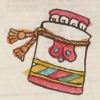Yeltzonquiauh (MH897r)
This black-line drawing of the compound glyph for the personal name Yeltzonquiauh (or Eltzonquiauh) is attested here as a man’s name. The glyph shows three elements: 1) at the top, the sign for heavy rain (quiahuitl), which has a triangular stream of water with two lines of current (movement) and a droplet/bead at the bottom of the stream; 2) then, coming downward, an amorphous internal organ, such as a liver (yelli or elli), with three vertical squiggly lines dividing it into sections and possibly referring to a person’s essence and being; and, finally, at the bottom, a considerable number of short straight line coming down from the organ and representing hair (tzontli).
Stephanie Wood
These three elements may be logographic, but the resulting meaning remains unclear. Further research is necessary. For examples of compound hieroglyphs that include internal organs, see below.
Stephanie Wood
dio. yeltzonquiauh veve
Diego Yeltzonquiauh, huehue
Stephanie Wood
1560
Jeff Haskett-Wood
hígados, órganos internos, pelo, cabello, lluvia fuerte, nombres de hombres

yel(li), an internal organ, and a metaphor for one’s being/essence, https://nahuatl.wired-humanities.org/content/yelli
el(li), liver or gall bladder, https://nahuatl.wired-humanities.org/content/elli
tzon(tli), hair or 400, https://nahuatl.wired-humanities.org/content/tzontli
quiahui(tl), heavy rain, https://nahuatl.wired-humanities.org/content/quiahuitl
Matrícula de Huexotzinco, folio 897r, World Digital Library, https://www.loc.gov/resource/gdcwdl.wdl_15282/?sp=866&st=image.
This manuscript is hosted by the Library of Congress and the World Digital Library; used here with the Creative Commons, “Attribution-NonCommercial-ShareAlike 3.0 License” (CC-BY-NC-SAq 3.0).





